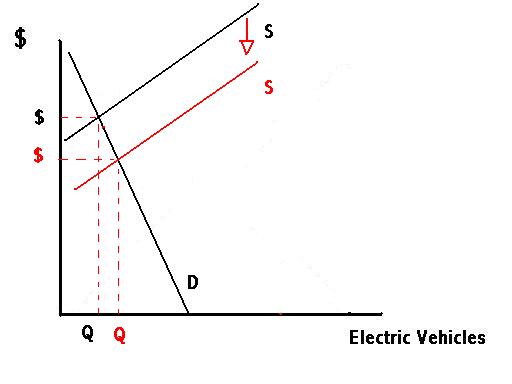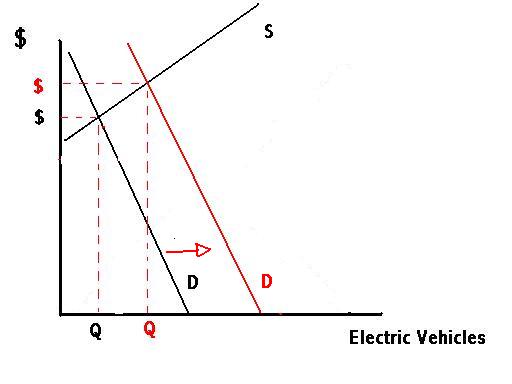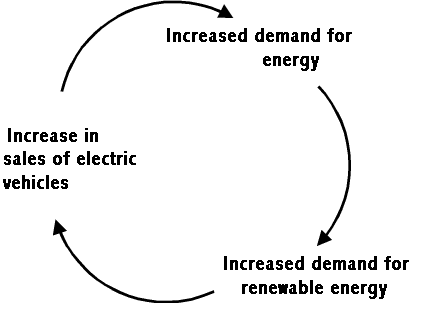Course:ECON371/UBCO2010WT1/GROUP8/Article5
Article 5 [1]
Inefficient use of unsustainable energy sources may lead to increased use of renewable energy
Summary
Alongside the newest generation of electric cars comes a technology that helps solve one major problem in the way of satisfactorily replacing our internal combustion-based vehicles. Unfortunately, this technology may not be considered environmentally-friendly, or even efficient. Since the problem of charging an electric vehicle is a massive responsibility on the part of the user, Evatran is trying to reduce the magnitude of this influence upon the demand for electric vehicles. With induction charging, an electric vehicle need only be parked over a base unit that is built into the floor. The system inside the vehicle will request the charge that is delivered through an electromagnetic field from the unit and convert it back to the form of an electronic current that the vehicle may store in its batteries. The downside of induction charging lies in the energy it wastes; about ten percent of the energy transferred will be lost. The representatives of this technology are convinced that this loss in energy is fair in exchange for the comforting feeling that the vehicle will always be charged. The company is helping to remove the barriers that currently stand in the way of electric vehicles. But others point to the fact that this energy waste nullifies the benefits of employing such vehicles. If the energy needed comes from unsustainable sources such as coal, electric vehicles may be no better, or maybe worse, than diesel-powered vehicles. Although it may seem counter-intuitive, this less-efficient technology may actually help drive the development of renewable resources. The technology could spur increased sales in electric vehicles, which then would entice people to look at where they get their energy, which would then drive demand for cheaper, renewable energies.
Analysis
The article begins with a lofty and questionably sincere proclamation that the latest technological successes regarding electric cars will "...help end the world's dependence on fossil fuels and clean the air." There is always talk of the newest and refined generation of electric vehicles that are always "...set to hit the market...", but somehow fail to make it to our local dealership. It is almost like the proverbial chicken and the egg: Which comes first? People would like to drive electric vehicles, but the necessary infrastructure has not been put in place, and this infrastructure will not be put in place unless there is a demand for electric vehicles.
The supply side of the electric vehicle market is characterized by high costs. As the supply curve demonstrates, there are significant costs involved at low levels of production, which come as a result of establishing very expensive supporting infrastructure. The demand for electric vehicles at this stage is very inelastic. Even as the technology improves and becomes slightly more affordable with every new development, the change in the amount of vehicles purchased does not change much. The demand market for electric vehicles has not been a force powerful enough to negate the problems surrounding supply.

This can be attributed to the reluctance of consumers to want to adopt a system they don't yet fully understand. People are still not willing to give up the certain comforts they enjoy with their current transportation. A recurring concern for potential electric vehicle owners revolves around the immense topic of charging. The frustrating experiences with other battery-operated technologies leaves consumers feeling apprehensive. But forgetting to charge a cell phone is not as serious as forgetting to charge your car. Switching to an electric vehicle comes with a whole new list of responsibilities, and these may be significant enough to stifle the demand for these at a consumer level. It may be considered as an potentially high abatement cost; for example, the cost of missing work or an important meeting as a result of an uncharged vehicle. It could be the inconvenience of waiting for the batteries to charge, or it could be the fear of a lack of availability of charging stations. There are many reasons why consumers are not entirely convinced that they, themselves, really want these cars. People haven't even begun using the charging stations, and they can already sense their inconvenience.
These issues are not having a positive effect on demand. But if demand were to shift, there would be a greater effect on the amount of electric cars sold than if consumers waited until the price of the technology came down through the usual means of developments. (Difference in Qs between both graphs.) In an attempt to create more demand, some companies are looking towards solving the problems that are anticipated by consumers. Evatran has developed the technology that permits wireless charging for full-size electric vehicles by parking over a base unit. This would help alleviate the concerns and reduce the responsibilities of the user with respect to charging the vehicle. But this does come with its own cost; in the form of energy waste. About ten percent of the energy used to recharge the batteries will be lost during the process, bringing down the environmentally-friendliness that electric vehicles were supposed to promote.

It seems like a step backward on the road to efficiency, but the article provides some insight on why this could be a step in the right direction after all. If this technology would serve to alleviate concerns and to increase demand for electric vehicles, then maybe this increased demand for power would stimulate an increased demand for renewable energies. After all, there would be no point to switching to electric vehicles if they weren't powered by sustainable resources. If renewable resources are then employed on a massive scale, energy now is abundant and cheap and the demand for electric vehicles skyrockets. This positive feedback loop could revolutionize the world. In effect, the ends would justify the means.

Prof's Comments
Very nice. You did discuss the externality impact, but did not include that in your graphical analysis.